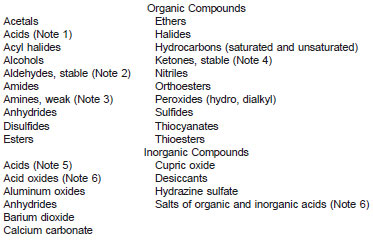3. Summary of Test Method
3.1 The sample, containing a maximum of 100 mg of water, is dissolved or dispersed in a suitable liquid and titrated with KF reagent, which consists of iodine, sulfur dioxide, organic base, and a solvent (typically an alcohol, such as methanol, ethylene glycol, or 2-methoxyethanol). The titration end point is determined amperometrically with a platinum electrode which senses a sharp change in cell resistance when the iodine is reduced by sulfur dioxide in the presence of water. (Warning - KF reagent contains four toxic compounds, namely, iodine, sulfur dioxide, pyridine or other organic bases, and methanol or glycol ether. The reagent should be dispensed in a well-ventilated area. Care must be exercised to avoid inhalation of the reagent or direct contact of the reagent with the skin.)
3.2 The general equation to this reaction is as follows:
H2O + I2 + SO2 + R'OH + 3 RN > (RNH)SO4R' + 2(RNH)I
where:
RN = an organic base such as pyridine, and
R'OH = alcohol.
4. Significance and Use
4.1 Titration techniques using KF reagent are one of the most widely used for the determination of water.
4.2 Although the volumetric KF titration can determine low levels of water, it is generally accepted that coulometric KF titrations (see Test Method E 1064) are more accurate for routine determination of very low levels of water. As a general rule, if samples routinely contain water concentrations of 500 ppm or less, the coulometric technique should be considered.
4.3 Applications can be subdivided into two sections: (1) organic and inorganic compounds, in which water may be determined directly, and (2) compounds, in which water cannot be determined directly, but in which interferences may be eliminated by suitable chemical reactions or modifications of the procedure. Further discussion of interferences is included in Section 5 and Appendix X2.
4.4 Water can be determined directly in the presence of the following types of compounds:

NOTE 1 - Some acids, such as formic, acetic, and adipic acid, are slowly esterified. For high accuracy with pyridine-based reagents, use 30 to 50 % pyridine in methanol as the solvent. When using pyridine-free reagents, commercially available buffer solutions16 can be added to the sample prior to titration. With formic acid, it may be necessary to use methanol-free solvents and titrants (1).
NOTE 2 - Examples of stable aldehydes are formaldehyde, sugars, chloral, etc. Formaldehyde polymers contain water as methylol groups. This combined water is not titrated. Addition of an excess of NaOCH3 in methanol permits release and titration of this combined water, after approximate neutralization of excess base with acetic acid (see Note 9).
NOTE 3 - Weak amines are considered to be those with Kb value <2.4 x 10(-5).
NOTE 4 - Examples of stable ketones are diisopropyl ketone, camphor, benzophenone, benzil, dibenzolacetone, etc.
NOTE 5 - Sulfuric acid up to a concentration of 92 % may be titrated directly; for higher concentrations see Note 13.
NOTE 6 - Compounds subject to oxidation-reduction reactions in an iodine-iodide system interfere.
5. Interferences
5.1 A number of substances and classes of compounds interfere in the determination of water by this titrimetric method, complete descriptions of which are found in the literature (2). This interference is associated with condensation or oxidation-reduction reactions.
5.2 Interferences of many classes of compounds can be eliminated by chemical reactions to form inert compounds prior to titration. The following are in this category:
Aldehydes and ketones, active (Note 7)
Amines, strong (Note 8)
Ammonia (Note 9)
Ferric salts (Note 10)
Hydrazine derivatives (Note 9)
Hydroxylamine salts (Note 11)
Mercaptans (Note 12)
Sodium methylate (Note 9)
Sulfuric acid (Note 13)
Thioacids (Note 12)
Thiourea (Note 12)
NOTE 7 - This interference may be reduced by use of pyridine rather than methanol as solvent for the same or by the use of KF reagent and solvent prepared with ethylene glycol monomethyl ether in place of methanol. For pyridine-free reagents, use ethylene glycol monomethyl-ether, ethylene glycol, benzyl alcohol or dimethylformamide in place of the methanol solvent and use a methanol-free titrant (1). The cyanhydrin reaction may be used to eliminate the interference (2).
NOTE 8 - Strong amines are considered to be those with Kbvalue >2.4 x 10(-5). Use salicylic acid-methanol solution (Section 7). Glacial acetic acid is applicable in certain cases.
NOTE 9 - Addition of acetic acid eliminates the interference.
NOTE 10 - Ferric fluoride does not interfere. Reaction with 8-hydroxyquinoline is reported to eliminate this interference (3).
NOTE 11 - With pyridine-based reagent, add 1 M SO2 in 1 + 1 pyridine-methanol or spent KF reagent. With pyridine-free reagents, the two component reagent methods should be used and 1 mL of sulfuric acid is added to the solvent prior to titration (Note 15).
NOTE 12 - Olefin addition reaction eliminates interferences (2). Oxidation with neutral iodine solution eliminates the interference of mercaptans (4).
NOTE 13 - Sulfuric acid, above 92 %. Add the sample (10 g) to a large excess of pyridine (35 mL), swirl to dissolve precipitate, and titrate. Addition of 8 mL of 1 + 1 pyridine-dioxane/1 g of sample also is satisfactory, maintaining a homogeneous solution throughout the titration.
5.3 If there is a question of compounds listed in 5.2 causing an interference, the recovery of spiked additions of water to the sample matrix should be checked.
5.4 Many materials react stoichiometrically with KF reagent. When their concentration is known, suitable corrections can be applied. A list of such materials is given in Appendix X2.



